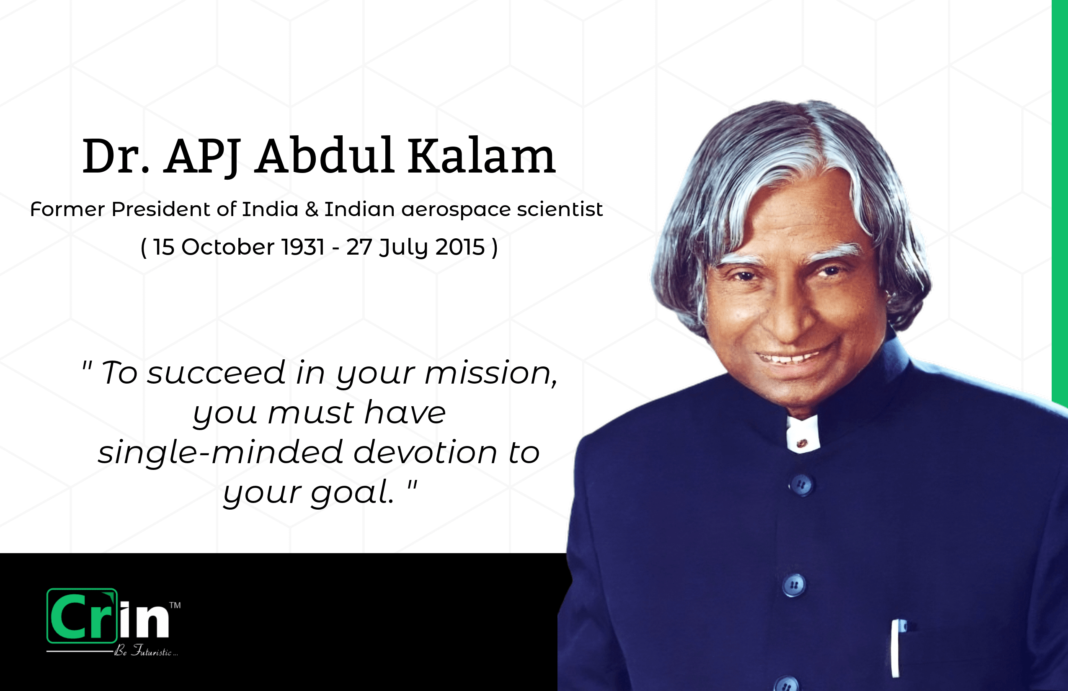Dr. Avul Pakir Jainulabdeen Abdul Kalam, fondly known as APJ Abdul Kalam, was a distinguished Indian aerospace scientist and the 11th President of India. Born on October 15, 1931, in Rameswaram, Tamil Nadu, Dr. Kalam’s life is a testament to the power of perseverance, dedication, and visionary thinking. His journey from a small town in Tamil Nadu to the Rashtrapati Bhavan in New Delhi is an inspiring tale of unwavering commitment to scientific and societal advancement.
Early Life and Education
Dr. Kalam was born into a humble family in Rameswaram. His father, Jainulabdeen, was a boat owner, and his mother, Ashiamma, was a housewife. Despite their modest means, his parents instilled in him a deep sense of integrity and discipline. Young Kalam exhibited a keen interest in learning and a fascination with flight, which was further kindled by his early education at the Schwartz Higher Secondary School in Ramanathapuram.
After completing his schooling, Kalam pursued a degree in physics at St. Joseph’s College, Tiruchirappalli. However, his passion for aerospace engineering led him to the Madras Institute of Technology (MIT), where he specialized in aeronautical engineering. This phase of his education laid the foundation for his illustrious career in aerospace science.
Career in Aerospace and Contributions to India’s Defense
Upon graduating from MIT, Dr. Kalam joined the Aeronautical Development Establishment of the Defence Research and Development Organisation (DRDO). His initial work involved designing a small helicopter for the Indian Army. However, his career took a significant turn when he moved to the Indian Space Research Organisation (ISRO) in 1969, where he served as the project director of India’s first Satellite Launch Vehicle (SLV-III).
The successful launch of the SLV-III in 1980, which deployed the Rohini satellite into orbit, marked a milestone in India’s space program and cemented Dr. Kalam’s reputation as a pioneering scientist. His contributions were not limited to space exploration. Dr. Kalam played a crucial role in the development of ballistic missile technology, earning him the moniker “Missile Man of India.” His work on the Agni and Prithvi missiles demonstrated India’s growing capabilities in defense technology.
The Pokhran-II Nuclear Tests
One of the most significant achievements of Dr. Kalam’s career was his involvement in the Pokhran-II nuclear tests in 1998. As the Chief Scientific Adviser to the Prime Minister and the Secretary of the DRDO, he led the team that conducted these tests, which positioned India as a nuclear-armed state. The success of Pokhran-II not only showcased India’s technological prowess but also enhanced its strategic position on the global stage.
Presidency: A Visionary Leader
In 2002, Dr. APJ Abdul Kalam was elected as the 11th President of India. His tenure as President, from 2002 to 2007, was marked by his unique approach to the role. Unlike his predecessors, Kalam sought to connect directly with the people, especially the youth, earning him the title “People’s President.” He leveraged his position to promote education, innovation, and national development.
Promoting Education and Innovation
Dr. Kalam was a staunch advocate for education and believed that empowering the youth through knowledge and innovation was crucial for the nation’s progress. During his presidency, he launched several initiatives aimed at fostering a spirit of inquiry and creativity among students. His interactions with students across the country inspired countless young minds to pursue careers in science and technology.
Vision 2020
A visionary leader, Dr. Kalam articulated his dream of transforming India into a developed nation by 2020. This vision was encapsulated in his book “India 2020: A Vision for the New Millennium,” co-authored with Y.S. Rajan. The book outlined a comprehensive plan for India’s development, focusing on areas such as agriculture, infrastructure, education, and healthcare. Kalam’s Vision 2020 continues to inspire policymakers and citizens alike.
Post-Presidency: Continuing the Mission
After completing his term as President, Dr. Kalam continued to engage with students and academia, delivering lectures and participating in educational initiatives. He served as a visiting professor at several prestigious institutions, including the Indian Institute of Management (IIM) Shillong, the Indian Institute of Space Science and Technology (IIST), and Anna University.
Inspiring Future Generations
Dr. Kalam’s post-presidency years were dedicated to mentoring and inspiring future generations. He wrote numerous books aimed at young readers, including “Wings of Fire,” an autobiography that chronicles his journey from Rameswaram to the Rashtrapati Bhavan. The book remains a source of inspiration for millions, emphasizing the importance of dreams, hard work, and perseverance.
Honors and Legacy
Dr. Kalam’s contributions to science, education, and national development have been widely recognized. He received numerous awards, including the Padma Bhushan (1981), Padma Vibhushan (1990), and Bharat Ratna (1997), India’s highest civilian honor. His legacy continues to resonate through the various educational and scientific institutions that he helped shape.
Dr. Kalam’s Enduring Influence
Dr. Kalam passed away on July 27, 2015, while delivering a lecture at IIM Shillong. His sudden demise was a profound loss for the nation, but his legacy endures. Institutions, scholarships, and awards have been established in his name, ensuring that his vision and ideals continue to inspire future generations.
Dr. APJ Abdul Kalam’s life story is a beacon of hope and motivation. His relentless pursuit of excellence, his commitment to education and innovation, and his deep love for his country make him an enduring icon in India’s history. As we reflect on his contributions, we are reminded of the power of dreams and the importance of working tirelessly to achieve them.
For Detailed Information, Kindly visit Wikipedia – A. P. J. Abdul Kalam



